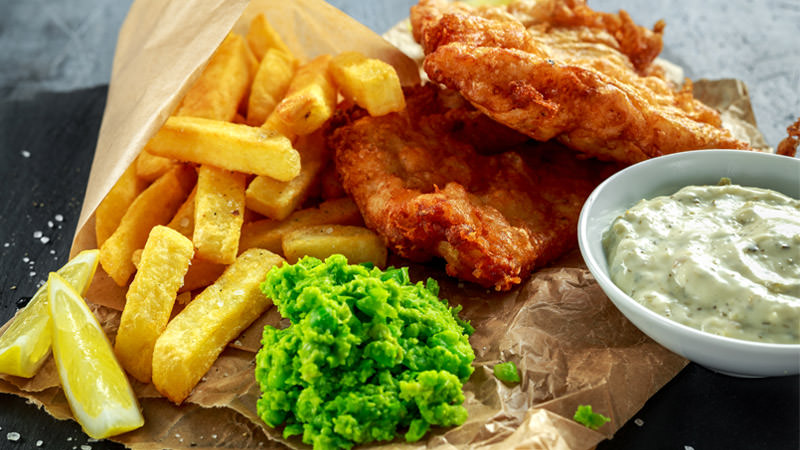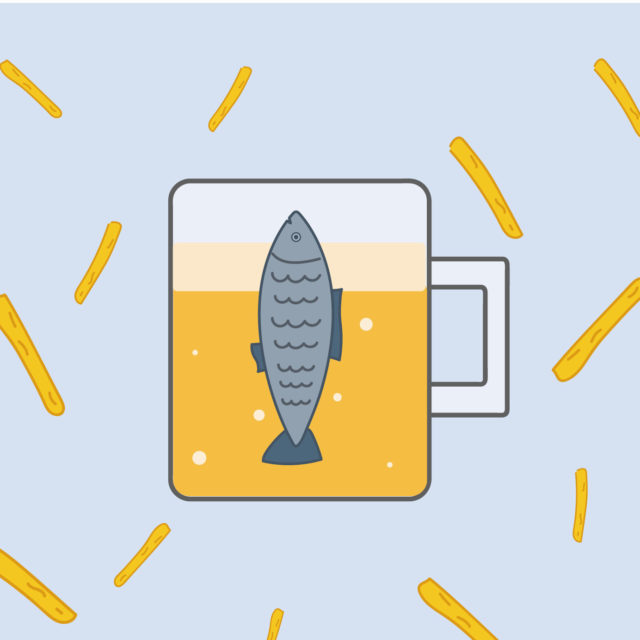No dish sings “Rule, Britannia!” quite as proudly as a plate of fish and chips. As British as rain delays at Wimbledon and double-decker London buses, the combination of golden, crispy, battered fish, and chunky chips (like French fries, only better), is enjoyed in every corner of the United Kingdom.
Traditionally served in fish and chip shops, called “chippies,” the dish also finds a home in village pubs, chain restaurants, and fancy gastropubs. When this writer worked as an apprentice chef at a five-star London hotel, the most popular dish on the bar menu (by far) was the fish and chips.
According to Professor John K. Walton, historian and author of “Fish and Chips and the British Working Class,” Londoners first cooked battered fish at around the same time Queen Victoria took the throne, in 1837. Fried “chipped” potatoes were invented some 40 years later in Lancashire, a county in the northwest of England. It’s not known who first combined the two ingredients, but the dish’s origins are believed to date to some time in the 1870s.
The secret to the dish lies within perfecting the batter. The ideal preparation sees a fillet of meaty white fish, such as cod, haddock, or pollock, served in a batter that’s light but crispy, fried but not greasy, and as golden as a pint of British ale.
Indeed, beer is a key ingredient in well-made fish and chips. Adding beer to a batter made from flour and water boosts flavor and provides a “lighter, crispier” coating, Gordon Ramsay explains in a 2005 episode of “The F Word.”
“Different beers produce slightly different results regarding the coloration of the final batter mix, and also the flavor,” says Andy Gray, the trade marketing manager of Seafish, a public body that supports the U.K. seafood industry. A blonde-style beer produces a “slightly sweeter batter mix,” Gray explains, while darker beers produce a “bitter-beer style flavor.”
The batter also protects the fish during cooking. As the mixture crisps, it forms a shell around the fish, locking in moisture and steam-cooking the fillet. “The quick frying methods used today and the high-quality oils used by fish and chip shops, mean that very little oil, if any, gets into the actual fish,” Gray says.
Heston Blumenthal, the chef and owner of three-Michelin-starred Fat Duck and Dinner by Heston Blumenthal (two Michelin stars), says the key to a crispy batter is carbonation. Blumenthal adds beer at the last minute, and advises against mixing too much so that bubbles aren’t lost. (A lumpy batter also provides an interesting texture, Blumenthal says.)
He adds his batter to a syphon and injects with carbon dioxide cartridges before chilling it. Carbon dioxide is much more soluble in chilled liquid, he explains, and cooling provides “more gas, more bubbles, and a crisper, lighter batter.”
Blumenthal also pioneered a method for cooking the “fluffiest, crispiest chips imaginable.” His triple-cooked chips see potatoes washed of starch, simmered in lightly salted water until almost cooked, confited at 250 degrees Fahrenheit, then crisped to a satisfying crunch in hot oil (around 365 degrees Fahrenheit).
At “chippies” and fine-dining establishments, chefs take certain liberties with the dish. Some fish and chip shops opt to fry their chips in beef dripping instead of oil. Many serve it with tartar sauce or mushy peas — a mint- and vinegar-spiked pea puree. No matter where you are in the country, chips are almost always seasoned with salt and malt vinegar.
Glaswegians enjoy their fish and chips with a side of pickled onions, while Manchester locals sauce with a splash of gravy. Birmingham residents enjoy with a curry-flavored dipping sauce and Londoners opt for mayonnaise.
Brits honor the dish on the first Friday of every June, when they celebrate National Fish and Chips Day. According to a 2014 survey, over a third of U.K. residents eat fish and chips more than once a month.

Traditional Beer-Battered Fish and Triple-Cooked Chips
(Serves 4)
Ingredients:
- 24 ounces potatoes (Maris Piper, Fontaine, or Maris Bard)
- Vegetable oil for frying
- 14 ounces plain flour and 1 ounce rice flour, kept in the freezer
- 18 fluid ounces very cold golden ale, such as Bombardier British Hopped Golden Ale
- Salt and pepper to taste
- 4 pieces of cod or haddock (around 7 ounces each, skin off)
Directions:
- Peel potatoes and cut into 2 x 1/2 inch batons. Place in a bowl and rinse under cold water until it runs clear, at which point you’ll have released most of the starch content.
- Cook in a gently simmering pan of lightly salted water until potatoes are soft to the touch but not cooked all the way through, approximately 15 to 20 minutes.
- Carefully remove the potatoes, place on a rack to drain, and cool in the fridge for 30 minutes.
- Heat the oil in a deep-bottomed pan to 265 degrees Fahrenheit. (Cooking in a pan rather than using a deep fat fryer allows for better temperature control.)
- Fry the chips in your pan in batches for around 7 minutes each. You want a light crust to form, but the chips should gain no color. Carefully remove, place on a rack, and cool in the fridge for another 30 minutes.
- Heat the oil to 365 degrees Fahrenheit, making sure there are no leftover pieces of potato — these will burn and alter the flavor of the oil. Heat a separate pan with oil for the fish, also to 365 degrees Fahrenheit.
- When the chips are cool and both pans of oil have reached 365 degrees, it’s time to make the batter. Remove the flour from the freezer and lightly whisk in the cold beer. Don’t mix too vigorously, and don’t worry about any small lumps.
- Pat the fish fillets with a paper kitchen towel, dust with flour, and season with salt and pepper.
- Dip the fish into the batter and then carefully lower it into the fresh hot oil. Using a spatula, hold the fish in place for a few seconds so the batter starts to crisp, then let go. This stops the fish from sinking and sticking to the bottom of the pan. Cook no more than two pieces at a time, as the fryer will become overcrowded and the temperature of the oil might drop. Cook for around 5 minutes, until the fillets are golden brown.
- Fry the potatoes in the chip pan, also in batches and also for around 5 minutes until crisp and golden.
- Remove fish fillets and chips using a slotted spoon, holding above the frier for a moment to allow excess oil to drip off. Serve immediately with a lemon wedge and your preferred garnish.
